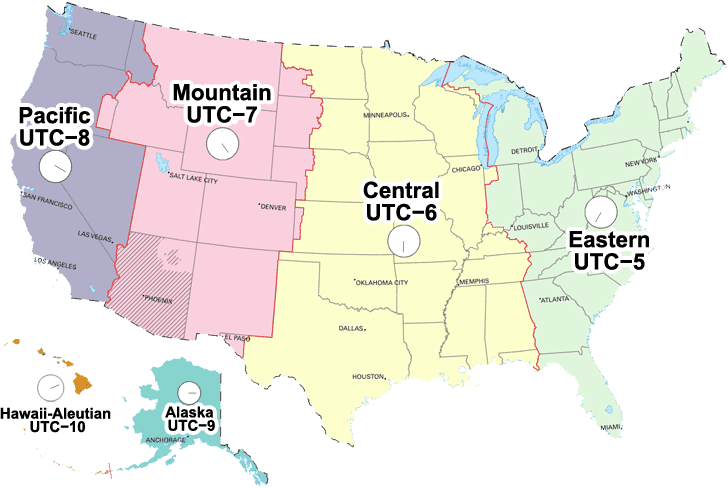
The low latitude and often stable weather in Florida, the Gulf Coast, and southern Arizona and California, are responsible for the rarity of episodes of severe cold relative to normal in those areas. Lower zones can be found in Alaska (down to 1). The far northern portion on the central interior of the mainland have some of the coldest zones (zones 5, 4, and small area of zone 3) and often have much less consistent range of temperatures in winter due to being more continental, especially further west with higher diurnal temperature variations, and thus the zone map has its limitations in these areas. The southern middle portion of the mainland and central coastal areas are in the middle zones (zones 8, 7, and 6). Higher zones can be found in Hawaii (up to 12) and Puerto Rico (up to 13). In the United States, most of the warmer zones (zones 9, 10, and 11) are located in the deep southern half of the country and on the southern coastal margins.
TIME ZONE CHANGES ZIP
State-by-state maps, along with an electronic system that allows finding the zone for a particular zip code, can be found at the USDA Agricultural Research Service (USDA-ARS) website. The USDA system was originally developed to aid gardeners and landscapers in the United States. United States hardiness zones (USDA scale) A heat zone (see below) is instead defined by annual high temperatures the American Horticultural Society (AHS) heat zones use the average number of days per year when the temperature exceeds 30 ☌ (86 ☏). Other hardiness rating schemes have been developed as well, such as the UK Royal Horticultural Society and US Sunset Western Garden Book systems. For example, a plant may be described as "hardy to zone 10": this means that the plant can withstand a minimum temperature of 30 ☏ (−1.1 ☌) to 40 ☏ (4.4 ☌).


Unless otherwise specified, in American contexts "hardiness zone" or simply "zone" usually refers to the USDA scale. It has been adapted by and to other countries (such as Canada) in various forms. The original and most widely used system, developed by the United States Department of Agriculture (USDA) as a rough guide for landscaping and gardening, defines 13 zones by long-term average annual extreme minimum temperatures. In some systems other statistics are included in the calculations. Global Plant Hardiness Zones (approximate)Ī hardiness zone is a geographic area defined as having a certain average annual minimum temperature, a factor relevant to the survival of many plants.


 0 kommentar(er)
0 kommentar(er)
